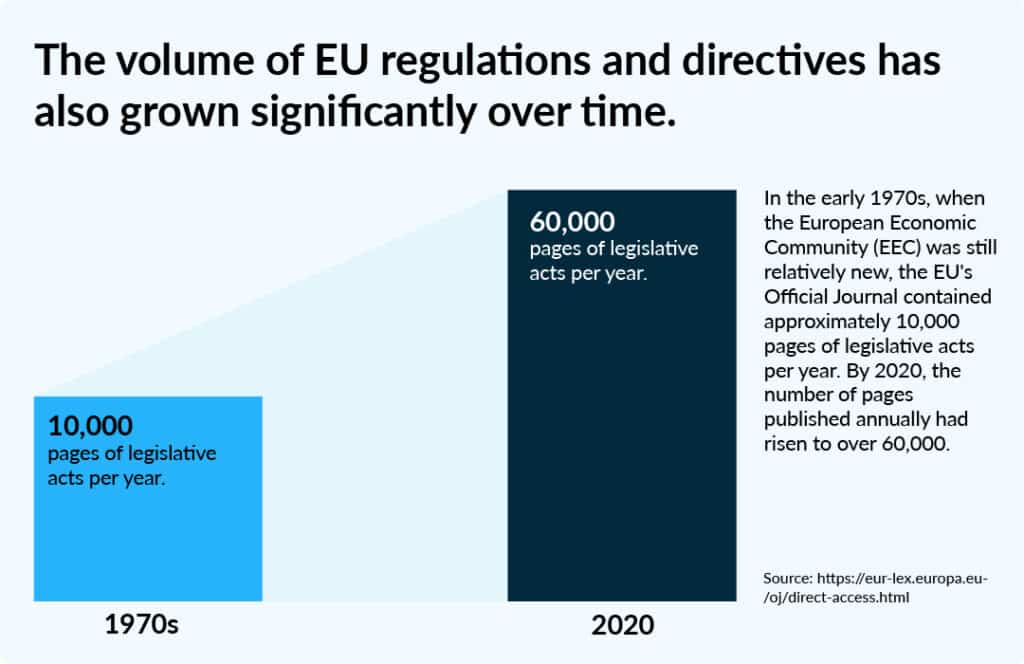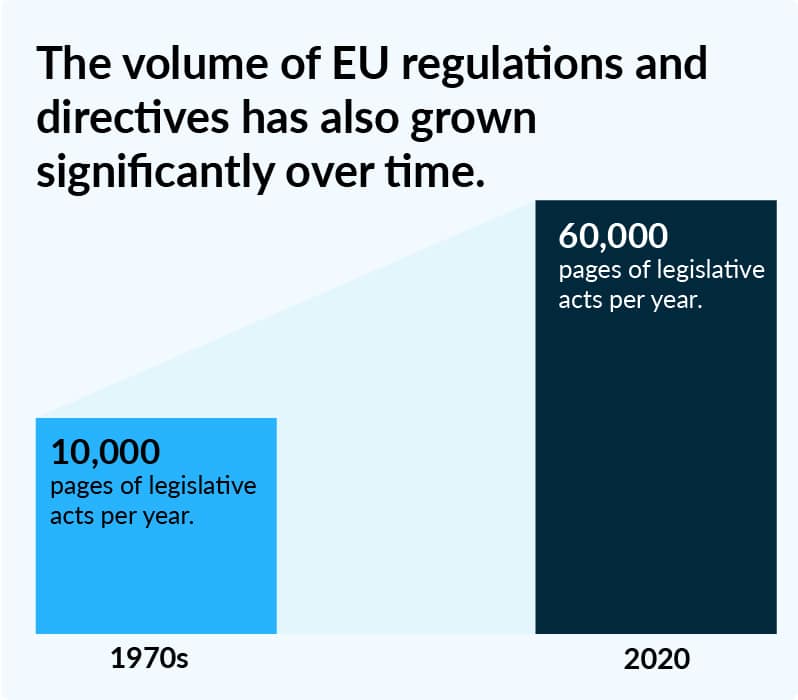Challenge 1: Complexity, volume and interdependence of regulations
Every day, the regulations are becoming more complex. This can overwhelm anyone, but especially legal architects. They must stay updated on changes across many industries and countries. Regulations are becoming more intricate, involving local, national, and global levels, with many dependencies between them. Legal architects often have to figure out how these laws impact multiple industries and sectors.For example, in the early 1970s, when the European Economic Community (EEC) was still relatively new, the EU’s Official Journal contained approximately 10,000 pages of legislative acts per year. By 2020, the number of pages published annually had risen to over 60,000.1


Challenge 2: No open standard for processing regulations — every analyst has their own method
One major issue legal architects face is the lack of standardized methods for handling regulations. Everyone processes legal frameworks differently, making it hard to create consistent compliance strategies across teams.
Suggested strategy:
Adopting standardized workflows or frameworks within the organization can eliminate this inconsistency. Legal teams should collaborate to develop best practices and invest in internal training programs that ensure everyone processes regulations in a uniform way, reducing errors and improving overall compliance.
Challenge 3: Difficulty in collecting and centralizing all relevant regulations
Legal architects often spend a lot of time gathering regulations from multiple sources like government websites and legal databases. Keeping track of this scattered information is stressful and time-consuming, leading to delays in applying the right legal frameworks.

Suggested strategy:
Consider using digital tools or setting up internal databases to centralize and manage regulatory information. A centralized platform will ensure all team members have easy access to the latest regulations and eliminate duplicated efforts. This ensures that everyone works from the same source, reducing confusion and errors.
Challenge 4: Tools and technology don’t always work
Many legal architects still use general-purpose tools like Word or Excel for complex legal analysis. These tools are not designed for regulatory work and often cause issues like data loss, formatting errors, and human error. In some cases, business design platforms lack important functions, making them difficult to use. Without tailored solutions, legal analysts may struggle to keep up with modern compliance demands.

Suggested strategy:
Exploring industry-specific legal software can alleviate many of these frustrations. Tools that cater to regulatory analysis, document management, and compliance monitoring can automate repetitive tasks like document generation, allowing legal architects to focus on higher-level decision-making.
Challenge 5: Chaotic communication and bureaucracy slow down processes
Legal architects often deal with slow processes due to multiple approvals or bureaucratic obstacles. Feedback from various stakeholders can cause delays, leading to inefficiency and frustration. Siloed communication adds to this problem, as teams struggle to stay aligned.

Suggested strategy:
Streamlining communication by setting up clearer channels or using collaboration tools can reduce these inefficiencies. Establishing cross-functional teams and defining workflows with fewer approval steps for routine processes will help reduce bottlenecks and expedite project timelines.
So, how to navigate all of this and succeed?
These challenges may seem overwhelming, but they can be overcome. By using strategies like compliance mapping, centralizing data, adopting standard workflows, and using RegTech tools, legal architects can manage complexity more effectively.
As regulations evolve, staying ahead requires constant adaptation and a willingness to embrace innovation. By applying these practical tips and improving workflows, legal architects can not only manage complexity but also thrive in their roles. One of the tools that can help you with that is the Workbench. It can assist you with interpreting regulations and make your daily work easier.







